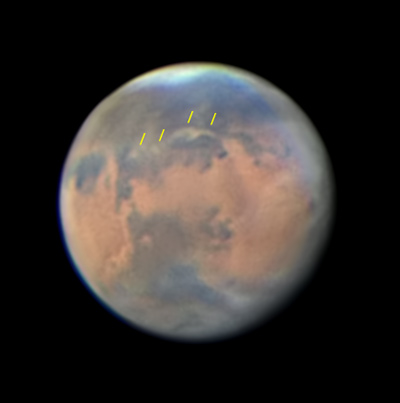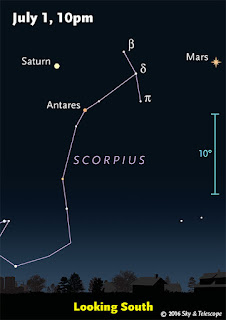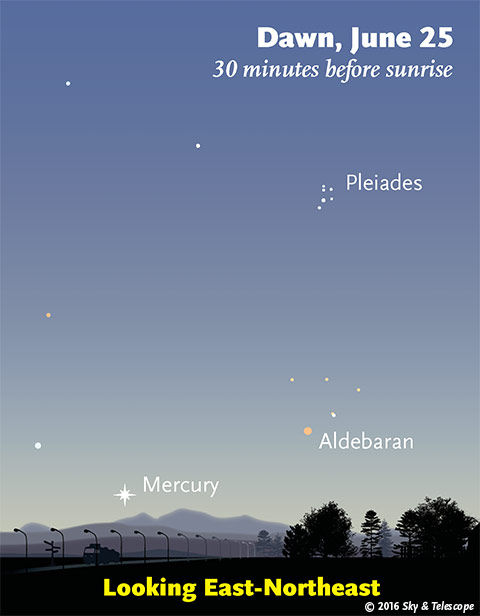This Week’s Sky at a Glance, June 24 – July 2:
Friday, June 24
• This is the time of year when the two brightest stars of summer, Arcturus and Vega, are about equally high overhead shortly after dark: Arcturus is toward the southwest, Vega is toward the east.
Arcturus and Vega are 37 and 25 light-years away, respectively. They're examples of the two commonest types of naked-eye stars: a yellow-orange K giant and a white A main-sequence star. They're 150 and 50 times brighter than the Sun — which, combined with their nearness, is why they dominate the evening sky.
Saturday, June 25
• At nightfall, look for the Big Dipper hanging straight down in the northwest. Its bottom two stars, the Pointers, point to the right toward modest Polaris, the handle-end of the Little Dipper.
The rest of the Little Dipper floats straight upward from Polaris — like a helium balloon escaped from some June evening party. Most of it is quite dim; through light pollution, you may only see Polaris and Kochab, the lip of the Little Dipper's bowl, 16° above it.
This
week, Mars is as far west (left) of Saturn and Antares as it's going to
get. Watch it move back toward them in the coming weeks — very slowly
at first, then with increasing speed.
Meanwhile, distant Jupiter is moving ever lower in the west.
• Three doubles at the top Scorpius. Mars and Saturn aren't the only telescopic attractions in the south these evenings, even you have heavy light pollution! The head of Scorpius — the near-vertical row of three stars upper right of Antares — stands to Saturn's right by about a fist at arm's length. The top star of the row is Beta (ß) Scorpii or Graffias, a fine double star for telescopes.
Just 1° below it (and a little too faint for the chart here) is the very wide naked-eye pair Omega1 and Omega2 Scorpii, not quite vertical. Binoculars show their slight color difference. Left of Beta by 1.6° is Nu Scorpii, another fine telescopic double. High power in good seeing reveals Nu's brighter component itself to be a close binary
 , separation 2 arcseconds.
, separation 2 arcseconds.Monday, June 27
• The last-quarter Moon (exact at 2:19 p.m. EDT) rises around 1 a.m. below the Great Square of Pegasus.
Tuesday, June 28
• Arcturus is the brightest star high in the west. Equally bright Vega is similarly high in the east. A third of the way from Arcturus to Vega, look for dim Corona Borealis, the Northern Crown, with its one modestly bright star, Gemma or Alphecca. Two thirds of the way, you'll find the dim Keystone of Hercules.
Wednesday, June 29
• As evening grows late, even the lowest star of the Summer Triangle climbs fairly high in the east. That would be Altair, a good three or four fists at arm's length below or lower right of bright Vega.
Look left of Altair, by hardly more than one fist, for the compact little constellation Delphinus, the Dolphin.
Thursday, June 30
• Vega is the brightest star very high in the east. Barely to its lower left after dark is one of the best-known multiple stars in the sky: 4th-magnitude Epsilon (ε) Lyrae, the Double-Double. It forms one corner of a roughly equilateral triangle with Vega and Zeta (ζ) Lyrae. The triangle is less than 2° on a side, hardly the width of your thumb at arm's length.
Binoculars easily resolve Epsilon, and a 4-inch telescope at 100× or more should resolve each of Epsilon's wide components into a tight pair.
Zeta Lyrae is also a double star for binoculars; much tougher, but easily split with any telescope. Delta (δ) Lyrae, below Zeta, is much wider and easier.
• Mars is stationary; it ceases its retrograde (westward) motion and will begin returning eastward toward Saturn and Antares. It will slingshot between them on August 23rd and 24th.
Friday, July 1
• Is your sky dark enough for you to see the Coma Berenices star cluster naked-eye? Just after the very end of twilight, spot Jupiter in the west. The cluster is above it by 25°, about 2½ fists at arm's length. Its brightest members form an inverted Y. The entire cluster is about 5° wide — a big, dim glow in a truly dark sky. It nearly fills a binocular view.
Saturday, July 2
• If you have a dark enough sky, the Milky Way now forms a magnificent arch across the whole eastern sky after nightfall is complete. It runs all the way from below Cassiopeia in the north-northeast, up and across Cygnus and the Summer Triangle in the east, and down past the spout of the Sagittarius Teapot in the south.
_________________________
Want to become a better astronomer? Learn your way around the constellations. They're the key to locating everything fainter and deeper to hunt with binoculars or a telescope.
This is an outdoor nature hobby. For an easy-to-use constellation guide covering the whole evening sky, use the big monthly map in the center of each issue of Sky & Telescope, the essential guide to astronomy.
The Pocket Sky Atlas
plots 30,796 stars to magnitude 7.6 — which may sound like a lot, but
it's less than one per square degree on the sky. Also plotted are many
hundreds of telescopic galaxies, star clusters, and nebulae. Shown above
is the new Jumbo Edition for easier reading in the night. Click image
for larger view.
Next up is the larger and deeper Sky Atlas 2000.0, plotting stars to magnitude 8.5, nearly three times as many. The next up, once you know your way around, is the even larger Uranometria 2000.0 (stars to magnitude 9.75). And read how to use sky charts with a telescope.
You'll also want a good deep-sky guidebook, such as Sue French's Deep-Sky Wonders collection (which includes its own charts), Sky Atlas 2000.0 Companion by Strong and Sinnott, or the bigger Night Sky Observer's Guide by Kepple and Sanner.
Can a computerized telescope replace charts? Not for beginners, I don't think, and not on mounts and tripods that are less than top-quality mechanically (meaning heavy and expensive). And as Terence Dickinson and Alan Dyer say in their Backyard Astronomer's Guide, "A full appreciation of the universe cannot come without developing the skills to find things in the sky and understanding how the sky works. This knowledge comes only by spending time under the stars with star maps in hand."
This Week's Planet Roundup
Good
luck catching Mercury before sunrise. It's bright but very low. Bring
binoculars or a wide-field telescope. It's in Taurus, not a
constellation most skywatchers associate with June. The visibility of
faint objects in bright twilight is exaggerated here.

The yellow ticks point down to dust clouds brewing on Mars on the night of June 14–15. South is up. The most distinct clouds are just south of Aurorae Sinus, in the area of the Valles Marineris canyon system (not visible). Glenn Jolly of Gilbert, Arizona, took this image with a 14-inch scope at 5:57 June 15th UT. Since then the clouds have moved and perhaps weakened.
Venus is hidden deep in the bright sunset.
Mars (magnitude –1.5, in Libra) is now only Sirius-bright; it was closest to Earth on May 30th. It's the yellow-orange point shining in the south during and after dusk. Mars shrinks from 17 to 16 arcseconds wide this week, as Earth pulls ahead of it in our faster orbit around the Sun. See our telescopic guide to Mars in the April Sky & Telescope, page 48, or the version online. And set our Mars Profiler for your time and date.
Jupiter (magnitude –1.9, at the hind foot of Leo) shines in the west during and after dusk. It's on the far side of its orbit from us, 34 arcseconds wide, almost the smallest it ever appears.
Saturn (magnitude +0.2, in southern Ophiuchus) glows about 20° east (left) of Mars. To Saturn's lower right by 6° or 7° sparkles Antares, half as bright. Look near the middle of the long Mars-Saturn-Antares triangle for Delta Scorpii (Dschubba). See our telescopic guide to Saturn in the June Sky & Telescope, page 48.
Uranus (magnitude 5.9, in Pisces) is the east before dawn begins.
Neptune (magnitude 7.9, in Aquarius) is higher in the southeast before dawn.
__________________________
All descriptions that relate to your horizon — including the words up, down, right, and left — are written for the world's mid-northern latitudes. Descriptions that also depend on longitude (mainly Moon positions) are for North America.
Eastern Daylight Time (EDT) is Universal Time (UT, UTC, or GMT) minus 4 hours.
__________________________
“This adventure is made possible by generations of searchers strictly adhering to a simple set of rules. Test ideas by experiments and observations. Build on those ideas that pass the test. Reject the ones that fail. Follow the evidence wherever it leads, and question everything. Accept these terms, and the cosmos is yours.”
— Neil deGrasse Tyson
https://linksredirect.com/?pub_id=11719CL10653&url=http%3A//www.flipkart.com/



No comments:
Post a Comment